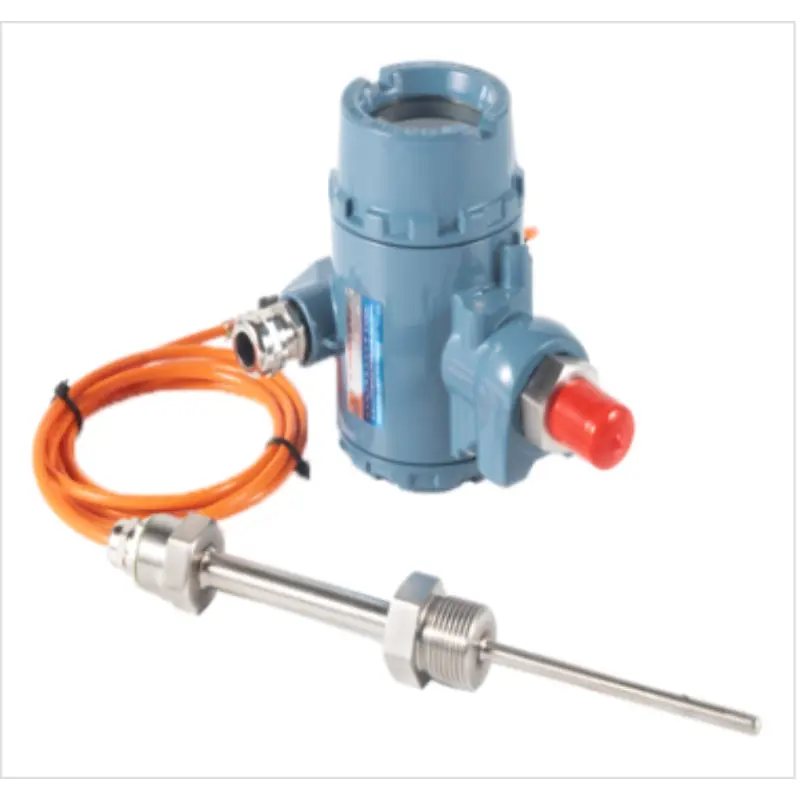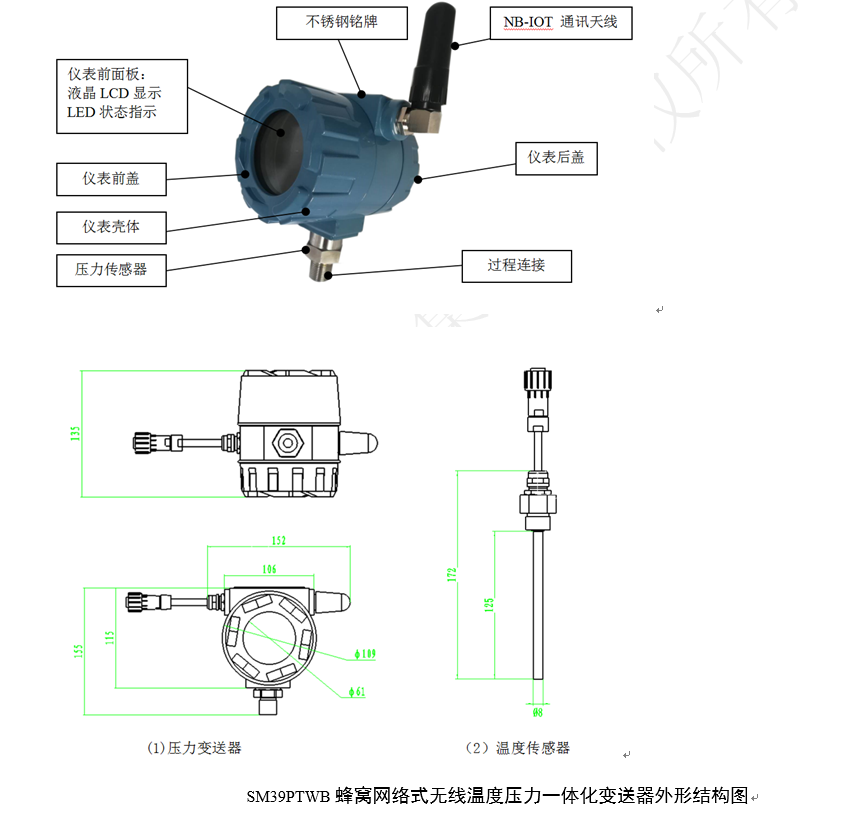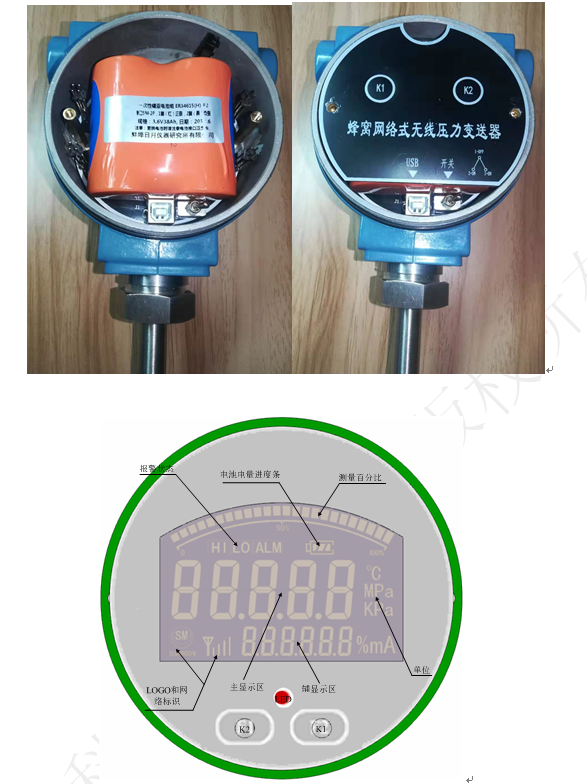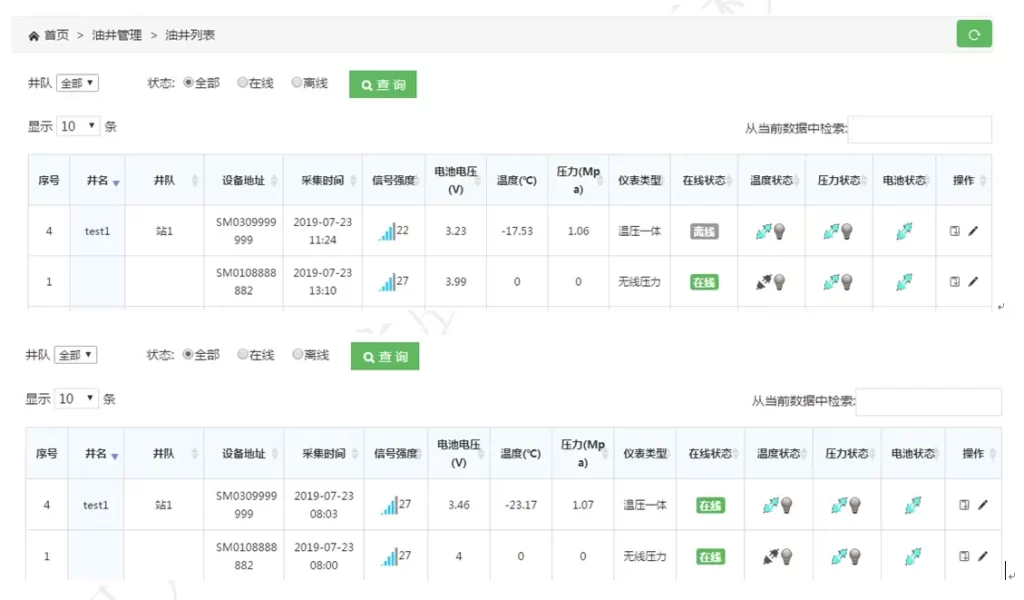
Temperature and pressure integrated transmitter / Cellular network wireless temperature and pressure integrated transmitter SM39PTWB
Product Categories Temperature and pressure integrated transmitter
Oilfield pipeline pressure, formation pressure of wells that are often shut down, pressure monitoring and upper and lower limit alarms; Explosion-proof design: explosion-proof aluminum shell, circuit board system is intrinsically safe; Protection level: IP68, fully sealed and waterproof design; The instrument can set alarm enable, upper and lower limits, delay, dead zone, maximum range, minimum range, decimal places, upload frequency, acquisition frequency, change alarm, and other parameters. LED indication: reset indication, configuration mode indication, network access indication, data acquisition indication; 4.5-digit LCD display: pressure data, battery capacity icon, upper and lower limit alarms, and other parameters. Adjustable installation direction: connected to the on-site pipeline valve through a live joint or adapter, the direction can be adjusted.
1. Features
- Oil field pipeline pressure, well formation pressure, pressure monitoring and upper and lower limit alarms;
- Explosion-proof design: explosion-proof aluminum shell, circuit board system is intrinsically safe;
- Protection level: IP68, fully sealed waterproof design;
- The instrument can set parameters such as alarm enable, upper and lower limits, delay, dead zone, maximum range, minimum range, number of decimal places, upload frequency, acquisition frequency, change alarm, etc.
- LED indication: reset indication, configuration mode indication, network access indication, data collection indication;
- 4.5-digit LCD display: pressure data, battery capacity icon, upper and lower limit alarms, and other parameters.
- Adjustable installation direction: It can be connected to the on-site pipeline valve through a union or adapter, and the direction can be adjusted.
2. Performance indicators
- Working environment temperature: -40~70℃
- Ambient humidity: 0~95%RH, no condensation;
- Protection grade: IP68;
- Explosion-proof mark: Ex ib II C T4 Gb, explosion-proof certificate: CE18.2230X;
- Power supply: ER34615 lithium thionyl chloride battery (implementation standard: SJ52278/1), two primary batteries in parallel, capacity 3.6V 38Ah; battery connector SM-2P (female: 1-pin positive, 2-pin negative) connected to the instrument; power supply voltage range, 3.0V~3.6VDC;
- Battery continuous working time: ≥1 year (pressure acquisition frequency 1 time/min, communication frequency 1 time/h);
- Battery replacement method: Open the back cover of the instrument and quickly replace it through the standard SM-2P interface;
- Long-term stability: drift, ±0.1%FS/year;
- Measuring performance: range, 0~2.5MPa, 0~6.0MPa, 0~25MPa, 0~40MPa, 0~60MPa; accuracy, 0.5%FS; can be customized according to actual needs; in accordance with GB/T 28474.1, GB/T 28474.2;
- Temperature and pressure sensor: adopts piezoresistive core & PT100 platinum resistor package, overload capacity, 150%FS;
- Process connection interface: M20X1.5 or 1/2''NPT, can be customized according to actual needs;
- Communication mode: 4G (full network access, compatible with 3G/2G);
- Communication protocol: follow the "Cellular Network Temperature and Pressure Transmitter Communication Protocol" to achieve oilfield DMZ server access;
- Online debugging and setting function: With online installation without uninstallation, the instrument can be debugged and set through the instrument panel or the configuration serial port and computer; the setting data content includes:
- Remote communication working parameters: server IP address, port number;
- Measurement working parameters: alarm enable, upper and lower limits, delay, dead zone, maximum range, minimum range, decimal places, upload frequency, acquisition frequency, change alarm;
After the instrument is powered off, the setting data is retained;
- Online upgrade: It can be realized by configuring the serial port and using a computer without uninstalling the installation.
- Liquid crystal (LCD) display: LCD display area, length × width = 45 × 35mm, the background color is green, the display content includes real-time measurement value, pressure unit, instrument range, battery power, voltage, signal strength; the decimal point of the real-time measurement value can be set, and 2 decimal places are retained by default;
- Instrument housing: Made of aluminum alloy, the housing seal (gasket) is silicone rubber, and the front and rear cover threads are coated with vaseline; the dial diameter is 60mm, and the exterior color is RAL5007;
- Overall dimensions: length × width × height = 150 × 130 × 235 mm (MAX).
- Sampling interval: The sampling interval can be set from 1 to 60 minutes.
- Sending interval: 5 to 1440 minutes.
Explosion-proof certification parameters
- Explosion-proof certificate number: CE18.2230X
- Explosion-proof mark: Ex ib ⅡC T4 Gb
- Appearance structure and function introduction

 Front panel LED: There are two colors, red and green. Red represents the pressure collection status and the sleep-to-wake-up status. The green LED represents the NB-IOT network link establishment status. Front panel reset: Through the magnet, just below the front cover of the shell, the magnet is facing the reset arrow upwards. After stabilizing for 3-5 seconds, remove the magnet. The red LED light flashes 3 times, and the LCD display 8888 also flashes three times synchronously, indicating that the instrument is reset successfully. The main purpose of the reset is to enter the instrument to modify the internal parameters, or refresh the current pressure value, and refresh and establish a network link. The instrument opens the back cover. There are batteries, buttons, switches, and USB debugging ports inside the back cover. The functions are as follows: Back panel K1: Due to the long reporting cycle of the instrument, during the debugging process, you can press the K1 button, and the instrument actively establishes a network link and reports the current set of pressure data. K1 is mainly used to debug whether the network is used normally. Back panel K2: Due to the long reporting cycle of the instrument, some application sites need to implement the time-to-time numbering of the current pressure. During the debugging process, you can press the K2 button, and the instrument actively continuously collects the current pressure for 300 seconds, and the LCD is synchronously refreshed in real time. This function is only for on-site collection and not uploaded. K2 is mainly used for on-site pressure debugging. Rear panel switch: The switch is divided into three gears: up, middle and down. The middle gear is in the closed state, and the up and down are in the open state. Rear panel USB: USB+debugging software, you can easily enter the IP address, network number, and other debugging parameters. For details, see the debugging software manual. Rear panel battery replacement: First turn off the power switch, unscrew the two M3 knurled screws on the left and right by hand, then vertically unplug the upper cover of the K1-K2 circuit board, disconnect the black plug of the battery SM, replace the new battery, reinsert the SM plug, and then gently insert the K1-K2 circuit board vertically against the pin, and finally manually tighten the two M3 knurled screws, turn on the switch, and pay attention to the whole process. The K1-K2 circuit board can be gently pulled out and inserted. Finally, please tighten the back cover. The actual photo is as shown below:
Front panel LED: There are two colors, red and green. Red represents the pressure collection status and the sleep-to-wake-up status. The green LED represents the NB-IOT network link establishment status. Front panel reset: Through the magnet, just below the front cover of the shell, the magnet is facing the reset arrow upwards. After stabilizing for 3-5 seconds, remove the magnet. The red LED light flashes 3 times, and the LCD display 8888 also flashes three times synchronously, indicating that the instrument is reset successfully. The main purpose of the reset is to enter the instrument to modify the internal parameters, or refresh the current pressure value, and refresh and establish a network link. The instrument opens the back cover. There are batteries, buttons, switches, and USB debugging ports inside the back cover. The functions are as follows: Back panel K1: Due to the long reporting cycle of the instrument, during the debugging process, you can press the K1 button, and the instrument actively establishes a network link and reports the current set of pressure data. K1 is mainly used to debug whether the network is used normally. Back panel K2: Due to the long reporting cycle of the instrument, some application sites need to implement the time-to-time numbering of the current pressure. During the debugging process, you can press the K2 button, and the instrument actively continuously collects the current pressure for 300 seconds, and the LCD is synchronously refreshed in real time. This function is only for on-site collection and not uploaded. K2 is mainly used for on-site pressure debugging. Rear panel switch: The switch is divided into three gears: up, middle and down. The middle gear is in the closed state, and the up and down are in the open state. Rear panel USB: USB+debugging software, you can easily enter the IP address, network number, and other debugging parameters. For details, see the debugging software manual. Rear panel battery replacement: First turn off the power switch, unscrew the two M3 knurled screws on the left and right by hand, then vertically unplug the upper cover of the K1-K2 circuit board, disconnect the black plug of the battery SM, replace the new battery, reinsert the SM plug, and then gently insert the K1-K2 circuit board vertically against the pin, and finally manually tighten the two M3 knurled screws, turn on the switch, and pay attention to the whole process. The K1-K2 circuit board can be gently pulled out and inserted. Finally, please tighten the back cover. The actual photo is as shown below:  The alarm status is displayed when an alarm is generated (the upper and lower limit alarms are not displayed at the same time). Only the main display area is displayed to display the alarm status of the physical quantity. The battery power is displayed according to the battery power. The battery voltage measurement percentage is the percentage of the measurement value in the range. The LOGO and network logo LOGO are always displayed, and the network logo is displayed according to the actual network status. The main display area is used to display the current value of the physical quantity, pressure or temperature, followed by a unit symbol. The auxiliary display area is used to display auxiliary information, unit logo, NB-IOT signal network logo, battery voltage and other units are displayed according to the instrument type requirements, which can be set to MPa, Kpa, ℃ Three physical dimensions Field installation instructions 5.1. All transmitters are digitally calibrated, and different transmitters have complete consistency and interchangeability; 5.2. During transportation, all transmitter batteries are disconnected. When installing the pressure transmitter on site, you need to unscrew the back cover of the meter head and turn on the battery switch. Pay attention to tightening the sheath to prevent water leakage; 5.3. When installing the cellular network wireless temperature and pressure integrated transmitter on the pipeline and the normally shut-down well, first close the valve (needle valve or gate valve) on the pipeline where the pressure transmitter is to be installed. Then there are two installation methods: (1). Screw the pressure transmitter directly into the upper port of the needle valve; (2) Screw the union or adapter into the upper port of the needle valve, and then screw the transmitter into the upper port of the union or adapter. This installation method adjusts the direction by adding a union or adapter. After installation, open the needle valve to confirm that there is no leakage, which means the installation is qualified; Install the temperature probe on the pipeline (1) The pipeline is shut down, depressurized, and emptied. Open a hole on the pipeline that is slightly larger than the outer diameter of the blind tube sleeve of the sensor probe; (2) Insert the blind tube sleeve vertically from the opening to the bottom of the pipeline, and then seal and weld it to the pipeline along the hole; (3) Inject heat transfer oil into the blind tube sleeve, about 1/2 of the volume of the pipe; (4) Insert the temperature sensor probe into the blind tube sleeve, adjust the direction of the meter head, tighten the joint with a wrench, and resume pipeline transportation. 5.4. Connect the cables of the temperature sensor and the pressure transmitter with waterproof plugs and sockets, and then perform pressure and temperature tests. After the installation of this cellular network wireless temperature and pressure integrated transmitter is completed, the network parameters can be set by pressing buttons or debugging tools. 5.5. If the transmitter is not used for a long time, the pressure transmitter can be set to sleep mode through the debugging tool (the transmitter is uniformly set to sleep mode or closed during the factory storage process, and it needs to be activated on site before it can be used normally). The online list of the debugging software interface is as follows: 6. Precautions 6.1. The battery model used in this product is ER34615M-3.6V38Ah; other types of batteries are prohibited. 6.2. The product antenna shell is made of plastic, which has potential electrostatic charge hazards! Avoid friction during use! Please wipe with a damp cloth when cleaning!
The alarm status is displayed when an alarm is generated (the upper and lower limit alarms are not displayed at the same time). Only the main display area is displayed to display the alarm status of the physical quantity. The battery power is displayed according to the battery power. The battery voltage measurement percentage is the percentage of the measurement value in the range. The LOGO and network logo LOGO are always displayed, and the network logo is displayed according to the actual network status. The main display area is used to display the current value of the physical quantity, pressure or temperature, followed by a unit symbol. The auxiliary display area is used to display auxiliary information, unit logo, NB-IOT signal network logo, battery voltage and other units are displayed according to the instrument type requirements, which can be set to MPa, Kpa, ℃ Three physical dimensions Field installation instructions 5.1. All transmitters are digitally calibrated, and different transmitters have complete consistency and interchangeability; 5.2. During transportation, all transmitter batteries are disconnected. When installing the pressure transmitter on site, you need to unscrew the back cover of the meter head and turn on the battery switch. Pay attention to tightening the sheath to prevent water leakage; 5.3. When installing the cellular network wireless temperature and pressure integrated transmitter on the pipeline and the normally shut-down well, first close the valve (needle valve or gate valve) on the pipeline where the pressure transmitter is to be installed. Then there are two installation methods: (1). Screw the pressure transmitter directly into the upper port of the needle valve; (2) Screw the union or adapter into the upper port of the needle valve, and then screw the transmitter into the upper port of the union or adapter. This installation method adjusts the direction by adding a union or adapter. After installation, open the needle valve to confirm that there is no leakage, which means the installation is qualified; Install the temperature probe on the pipeline (1) The pipeline is shut down, depressurized, and emptied. Open a hole on the pipeline that is slightly larger than the outer diameter of the blind tube sleeve of the sensor probe; (2) Insert the blind tube sleeve vertically from the opening to the bottom of the pipeline, and then seal and weld it to the pipeline along the hole; (3) Inject heat transfer oil into the blind tube sleeve, about 1/2 of the volume of the pipe; (4) Insert the temperature sensor probe into the blind tube sleeve, adjust the direction of the meter head, tighten the joint with a wrench, and resume pipeline transportation. 5.4. Connect the cables of the temperature sensor and the pressure transmitter with waterproof plugs and sockets, and then perform pressure and temperature tests. After the installation of this cellular network wireless temperature and pressure integrated transmitter is completed, the network parameters can be set by pressing buttons or debugging tools. 5.5. If the transmitter is not used for a long time, the pressure transmitter can be set to sleep mode through the debugging tool (the transmitter is uniformly set to sleep mode or closed during the factory storage process, and it needs to be activated on site before it can be used normally). The online list of the debugging software interface is as follows: 6. Precautions 6.1. The battery model used in this product is ER34615M-3.6V38Ah; other types of batteries are prohibited. 6.2. The product antenna shell is made of plastic, which has potential electrostatic charge hazards! Avoid friction during use! Please wipe with a damp cloth when cleaning!



